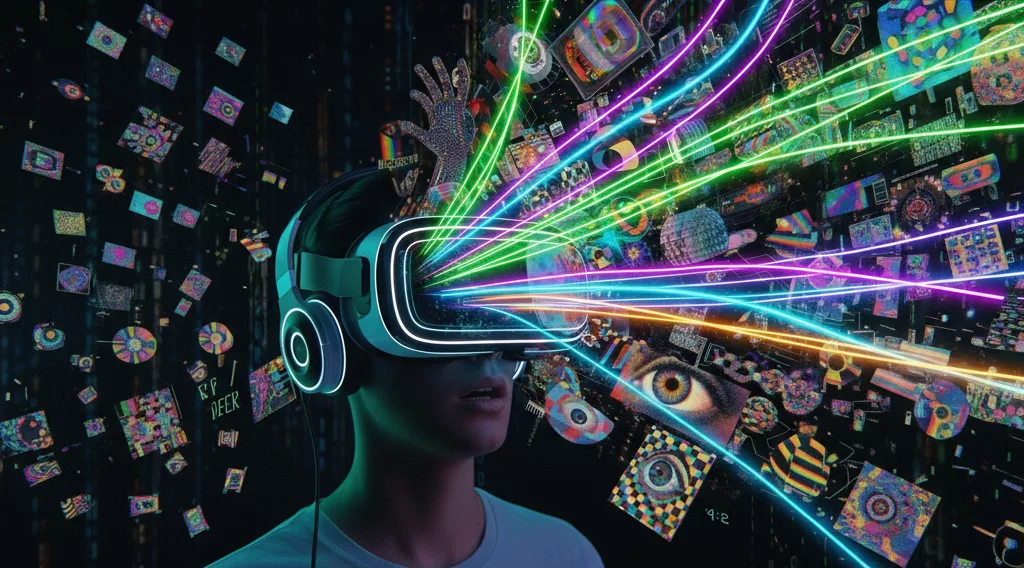Creating compelling VR experiences on Quest 2 requires balancing visuals with mobile hardware constraints. After analyzing apps like Visionarium (4.8★) and research from psychedelic VR studies, here are the 10 most effective techniques for Quest 2’s Snapdragon XR2 processor.
Foundation Effects
1. Flow-Based UV Distortion with Audio Reactivity
Flow-based distortion creates liquid “breathing” visuals by warping UV coordinates with dual-phase flow mapping. Move calculations to vertex shaders for 40% performance boost.
Audio integration: Use AudioSource.GetSpectrumData() with 512-sample FFT, dividing into bass (0-250Hz), mid (250-1000Hz), and treble (1000Hz+). Update at 30Hz. Performance target: 11.11ms frame time at 90Hz.
2. Fractal Kaleidoscope Patterns
Iterative function systems with modified Mandelbrot calculations create self-similar patterns. Limit iterations to 8-16 maximum with early termination.
Optimization: Replace trigonometric functions with 256×1 lookup textures (25% improvement). Use compute shaders with 32-thread groups and ASTC 6×6 compression for 75% memory reduction.
3. GPU Particle Systems with Feedback Trails
Ping-pong render texture technique with 512×512 RGB565 buffers creates persistent trails. Use billboard particles instead of meshes (80% vertex reduction). Limit: 5,000 particles maximum, maintaining 80 FPS.
Enhancement Effects
4. Chromatic Aberration
Separate RGB channels with different UV offsets create prismatic effects. Use mobile-optimized shaders for URP and VR. Apply at half resolution with bilateral upsampling.
5. Recursive Mirror Infinity
Quest 2 limits practical use to 2 recursions on 2 simultaneous surfaces. Use single-pass stereo rendering with render texture ping-ponging. Reduce mirror resolution by 50% with aggressive LOD.
6. Volumetric God Rays
Raymarching computes fog accumulation and light dispersion. Performance specs: 8-16 light beams, 16-32 raymarching samples, 50% screen resolution, 3-5ms frame impact. See Unity lighting documentation.
7. Displacement Mapping
Screen Space Displacement creates surface warping without tessellation. Move displacement to vertex shaders and use compressed ASTC textures. Vertex budget: 200,000-400,000 vertices total.
8. Temporal Dithering
Generate noise patterns over time for surfaces that “breathe” organically. Apply low-frequency noise (2-8Hz) to avoid motion sickness. Pre-compute noise textures and scroll through them.
9. Multi-Layer Parallax
Animate multiple texture layers at different speeds for depth illusions. Limit to 4-6 layers with 20-30% fill-rate impact. Use texture arrays and view-dependent culling.
10. Procedural Environment Generation
Real-time generation creates evolving environments. Use compute shaders for noise generation, aggressive mesh decimation for distant chunks, and stream texture atlases. Budget 2-3ms per frame for updates.
Technical Framework
Performance Budget (72Hz Target)
- Flow distortion: 4-6ms
- Fractals: 3-4ms
- Particles: 3-5ms
- Chromatic aberration: 2-3ms
- Total: 22-33ms (6-11ms headroom)
Unity Setup
- Rendering: Universal Render Pipeline with single-pass stereo
- Performance: 200-300 draw calls, 750k-1M triangles, 512MB texture memory
- Audio: Centralized spectrum analysis with Job System and Burst compiler
Adaptive Quality
set up dynamic scaling based on performance monitoring frame times and adjusting quality dynamically.
Success Stories
- Visionarium: Flow distortion + audio reactivity
- Ayahuasca: Kosmik Journey: Fractal patterns (Tribeca winner)
- Mediana: Multi-layer parallax + volumetric lighting
Optimization Principles
- Mobile-first GPU: Prioritize vertex over fragment calculations
- Texture lookups: Replace runtime math with pre-computed tables
- Aggressive LOD: Distance-based quality reduction
- Thermal management: Monitor device temperature
- Motion sickness: Limit displacement magnitudes, use low frequencies
Audio-Visual Synchronization
Centralize audio analysis for efficiency. Process spectrum data once per frame and distribute to all effects via global shader properties.
Performance Monitoring
- Frame rate: Consistent 72+ FPS
- Thermal throttling: Monitor CPU/GPU temperatures
- Battery: Optimize for 2+ hour sessions
- Memory: Stay under 3GB allocation
Conclusion
These techniques represent mobile VR’s cutting edge. Success comes from orchestrating multiple subtle effects rather than single intense visuals. Research suggests VR can induce unique altered states, opening frontiers for therapeutic applications and consciousness exploration.
Quest 2’s constraints force elegant solutions. Begin with flow-based distortion for maximum impact, then layer additional effects based on your performance budget. The future of psychedelic VR isn’t just replicating traditional experiences—it’s creating entirely new forms of consciousness exploration unique to virtual space.
Resources & Tools
- Meta Quest Developer Hub – Official Meta Quest development documentation and SDKs
- Unity XR Interaction Toolkit – Unity official VR interaction framework
- Oculus Integration Package – Official Meta Quest Unity integration
- Hand Tracking SDK – Meta documentation for hand tracking implementation
- Khronos OpenXR Standard – Cross-platform VR/AR standard supported by Meta Quest
- VR Performance Optimization – Meta best practices for Quest 2 performance
